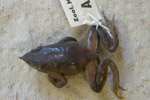Rachel Carson and, more recently, Sandra Steingraber have successfully drawn popular attention to the risks of pesticides on wildlife. Many of the environmental consequences of pesticides have now been well documented by scientists; however, studies investigating the evolutionary consequences of pesticides on non-target species are largely missing. Not surprisingly, most studies looking at how species evolve in response to pesticide-use have been on target species such as mosquitoes and crop pests, which show that some target species have evolved resistance to common pesticides. But, in a new study in Evolutionary Applications, Rickey Cothran and his colleagues at the University of Pittsburgh are the first to show evidence that non-target species, in this case frogs, may also evolve resistance to two popular pesticides.
 Photo courtesy of DDauri Daniel D’Auria under a Creative Commons Attribution-Share Alike 3.0 Unported. |
In this study, wood frogs’ (Lithobates sylvaticus) tadpoles were exposed to two chemical pesticides, Chlopyrifos and Roundup, in order to determine variation in resistance. Egg masses were collected from ponds near agricultural fields. These were hatched in laboratory conditions and then exposed to the two pesticides for 48 hours in order to assess each population’s level of tolerance to the pesticides. The researchers found that wood frogs closer to agricultural fields had higher survival rates when exposed to Chlopyrifos than populations further from agricultural fields. This indicates that some wood frog populations have developed resistance to this pesticide. Amazingly, these wood frogs may be the first vertebrate species to show such resistance.
Chlorpyrifos, is an organophosphate pesticide that was introduced by DOW chemical company in 1965. The pesticide kills insects such as aphids, mites, and various worms that destroy food and feed crops. It is the most commonly used pesticide in the United States with over 10 million pounds applied annually, however Chlorpyrifos has been shown to be highly toxic to many non-target animals, including amphibians, fish, and bees.
Despite the surprising findings on Chlopyrifos, the researchers found no evidence that wood frog populations have gained resistance to the herbicide Roundup. The most common herbicide in the U.S., Roundup (Glyphosate), is a broad-spectrum pesticide used to suppress and kill weeds. In 2007, the U.S. agriculture sector used more than 180 million pounds of Roundup; more than 5 million pounds was used by residential home and garden users, and industry, commerce, and the government used more than 13 million pounds.
When asked why the wood frog evolved resistance to Chlopyrifos but not Round-up, Cothran told mongabay.com, “It could be that the herbicide is more broadly applied (e.g., outside of the agricultural sector) so that populations that were not near agriculture may have been exposed.”

Photo courtesy W-van via a Creative Commons Attribution 3.0 Unported. |
Cothran went on to say that this didn’t preclude the possibility of frogs evolving resistance to Round-up, “but we need a better idea of past exposure histories to get at this question.”
The study hints that while pesticides harm many non-target species such the wood frogs, some animals may be able to evolve resistance. This resistance could provide declining amphibian populations time as society works to find substitutes or alternative solutions to harmful pesticides.
Luckily, Dr. Cothran has further research planned: “Our lab is working on a number of projects centered on understanding how evolutionary responses in aquatic organisms (including amphibians) to pesticides affects the way ecosystems function.”
CITATION: Cothran, R., Brown, J., Relyea, R., 2013. Proximity to agriculture is correlated with pesticide tolerance: evidence for the evolution of amphibian resistance to modern pesticides. Evolutionary Applications. p. 832-841.
Related articles

(04/10/2013) New Zealand’s Department of Conservation (DOC) is facing a backlash over plans to aerially drop a controversial poison, known as 1080, over the habitat of two endangered, prehistoric, and truly bizarre frog species, Archey’s and Hochsetter’s frogs, on Mount Moehau. Used in New Zealand to kill populations of invasive mammals, such as rats and the Australian long-tailed possum, 1080 has become an increasingly emotive issue in New Zealand, not just splitting the government and environmentalists, but environmental groups among themselves. Critics allege that the poison, for which there is no antidote, decimates local animals as well as invasives, while proponents say the drops are the best way to control invasive mammals that kill endangered species like birds and frogs and may spread bovine tuberculosis (TB).
New poison dart frog discovered in ‘Lost World’
(07/19/2013) Scientists have described a new species of poison dart frog after discovering it during a study to determine the impact of tourism on biodiversity in a tract of rainforest known as ‘The Lost World’ in Guyana.
Vocal-sac breeding frog possibly extinct

(07/02/2013) Somewhere in the wet pine forests of Chile, a male frog is gulping-up a bunch of eggs. No he’s not eating them, he’s just being a good dad. Darwin’s frogs are known for their unique parenting-style: tadpoles are incubated in the vocal sac of the father. First recorded by Charles Darwin during his world famous voyage aboard the Beagle, the amphibians were common in the native Chilean pine forests until the last few decades. Now, scientists believe that one of the two species, the northern Darwin’s frog (Rhinoderma rufum), may have vanished for good. And the other is hanging on by a thread.